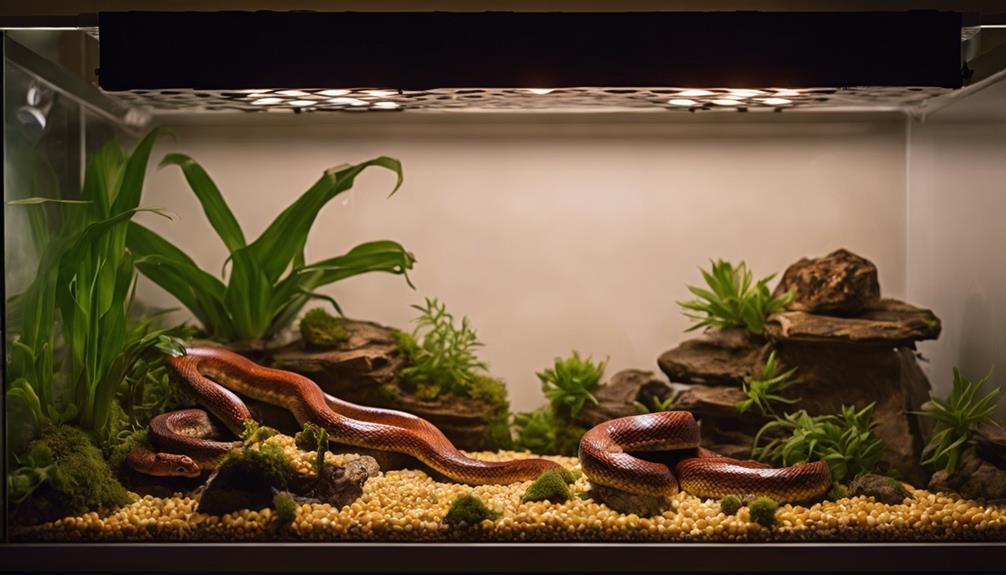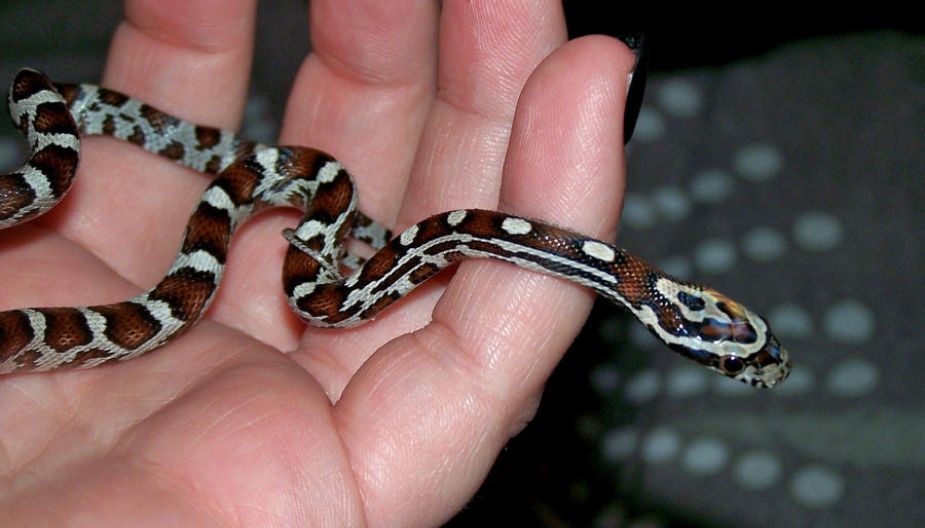The discussion about whether UVB light is a crucial requirement for the optimum health of corn snakes is still ongoing. Some resources strongly suggest its advantages, while others challenge its essentiality.
To comprehend the intricacies of UVB exposure in corn snakes, one needs to take into account the different elements that affect their health. Further investigation into these factors can provide insights into this complex issue, assisting you in making knowledgeable choices for your corn snake’s care.
Key Takeaways
- UVB light is crucial for corn snakes’ bone health and overall well-being.
- UVB exposure aids in preventing metabolic bone disease and supports calcium metabolism.
- Providing UVB lighting helps in maintaining a healthy immune system and organ function.
- UVB deficiency can lead to developmental issues, poor growth, and weakened immune systems in corn snakes.
Importance of UVB Light for Corn Snakes
Indispensable for the well-being of corn snakes, UVB light plays an essential role in their metabolism and overall health. UVB light is critical for corn snakes as it aids in preventing metabolic bone disease by helping them metabolize calcium effectively.
Additionally, UVB exposure is necessary for Vitamin D3 synthesis, which is important for proper bone development and overall health in corn snakes. Without adequate UVB light, corn snakes may suffer from various health issues such as weakened bones, stunted growth, and reproductive problems. UVB lighting also plays a significant role in maintaining a healthy immune system and supporting the proper functioning of organs in corn snakes.
Providing the right amount of UVB light replicates the natural sunlight exposure that wild corn snakes rely on for their well-being and vitality. Ensuring that your pet corn snake receives adequate UVB exposure is essential for their overall health and longevity.
Factors Influencing UVB Necessity
While UVB lighting is not a strict requirement for the health of corn snakes, understanding the factors that influence its necessity can provide valuable insights into their care and well-being. Corn snakes do not need UVB exposure to survive, but certain factors can influence whether it is beneficial or potentially harmful. Here is a table summarizing the key factors influencing the necessity of UVB lighting for corn snakes:
| Factors | UVB Necessity for Corn Snakes |
|---|---|
| Morph Type | Non-red-eyed morphs may benefit from UVB for enhanced color and activity levels. Red-eyed morphs are more sensitive to UVB and can suffer harm from excessive exposure. |
| Breeding Practices | Successful breeding without UVB exposure in most cases indicates its non-essential nature for corn snakes. |
| Environmental Enrichment | Providing hiding spots in the enclosure allows snakes to regulate their UV light exposure effectively. |
Understanding these factors can help you make informed decisions when considering whether to provide UVB lighting for your corn snake.
Risks of UVB Deficiency in Snakes
Understanding the risks associated with UVB deficiency in corn snakes is essential for maintaining their overall health and well-being. Without adequate exposure to UVB lighting, these snakes are prone to various health issues that can greatly impact their quality of life.
- Metabolic Bone Disease: UVB deficiency can lead to metabolic bone disease, affecting the snake’s bone health and leading to skeletal deformities.
- Calcium Absorption: Lack of UVB exposure results in decreased calcium absorption, which is vital for maintaining strong bones and overall bodily functions.
- Weakened Immune Systems: Corn snakes deprived of UVB may suffer from weakened immune systems, making them more susceptible to infections and illnesses.
It is clear that providing proper UVB lighting is essential for preventing developmental issues, poor growth rates, and reduced lifespan in corn snakes. By understanding these risks, you can take proactive steps to safeguard the well-being of your pet snake.
Ways to Provide UVB for Corn Snakes
To guarantee excellent health for your corn snake, utilize a 22-long, low-intensity 6% T5 HO fluorescent tube for UVB lighting in their enclosure. Providing UVB lighting is essential as it replicates the natural sunlight exposure necessary for your corn snake’s best health.
UVB lighting plays a vital role in calcium metabolism, contributing greatly to the overall well-being of your pet in captivity. Remember to replace the UVB bulbs according to the manufacturer’s recommendations to maintain the proper UV output required for your snake.
It’s important to offer UVB exposure alongside suitable heat sources to create a well-balanced environment for your corn snake. By incorporating these elements into your snake’s habitat, you can make sure they receive the necessary UVB lighting to thrive and stay healthy in captivity.
Debunking Common UVB Myths
Debunk common myths surrounding UVB lighting for corn snakes to guarantee accurate care practices and peak well-being for your pet. While UVB lighting has been a topic of debate among reptile enthusiasts, the truth is that corn snakes don’t need UVB to thrive.
Here are some important points to take into account:
- UVB isn’t a necessity: Corn snakes can live a healthy life without UVB light in captivity, as they don’t rely on it in their natural habitat.
- Proper husbandry is key: Instead of focusing solely on UVB lighting, make sure your corn snake’s enclosure provides adequate heating, humidity levels, and a well-rounded diet.
- Optional for some morphs: While UVB lighting may offer benefits for specific morphs, it isn’t a mandatory component for the general care of corn snakes. Focus on the essential aspects of care to guarantee your snake’s well-being without unnecessary additions.
Frequently Asked Questions
Do Snakes Need UVB?
You don’t need UVB for snakes. It’s a myth that UVB is essential. There are alternatives like natural light. UVB sources are optional. You can skip UVB supplementation for snake health. Just provide a proper day-night cycle.
What Light Is Best for Corn Snakes?
For corn snakes, the best light includes natural sunlight or artificial lighting with a balanced ultraviolet spectrum. Establish a lighting schedule to maximize health benefits. Tailoring light sources can enhance color, activity, and well-being.
Should I Turn My Corn Snakes Heat Lamp Off at Night?
At night, verify nighttime temperatures drop for best heat regulation. This supports corn snakes’ nocturnal behavior, circadian rhythms, and sleep patterns. Mimicking natural cycles aids in reducing stress and promoting their well-being.
Can a Corn Snake Live Without a Heat Lamp?
Without a heat lamp, a corn snake may struggle to regulate its body temperature properly, impacting its natural behavior, digestion process, and overall health. Behavioral changes and health implications could arise without adequate heating sources.
Conclusion
To sum up, while UVB lighting may not be a strict requirement for the health of corn snakes, it can enhance their color and activity.
It’s crucial to contemplate the individual needs of each snake, especially red-eyed morphs, who may be sensitive to UVB exposure.
Providing hiding spots in the enclosure and monitoring for any adverse reactions to UV lighting are essential practices for corn snake care.
Remember, a little extra care can go a long way in ensuring the well-being of your scaly friend.


